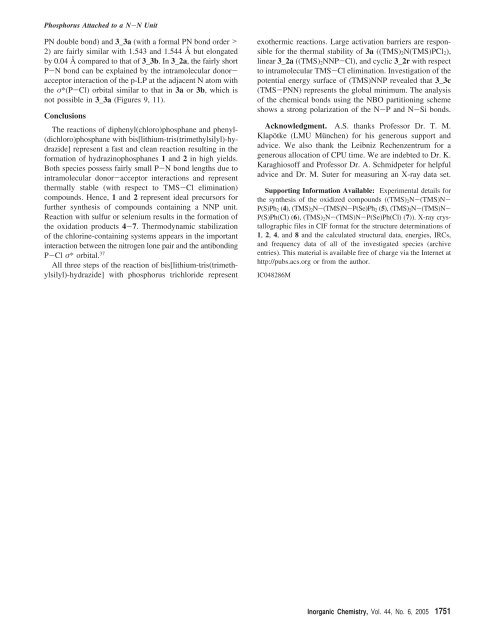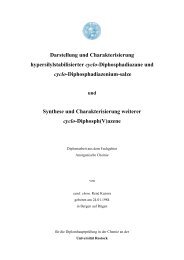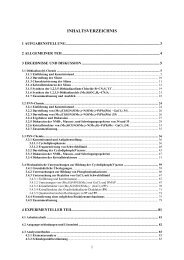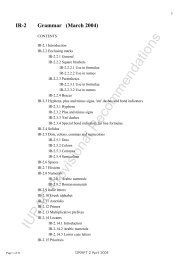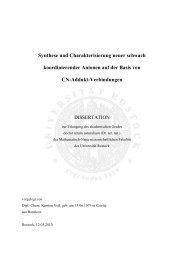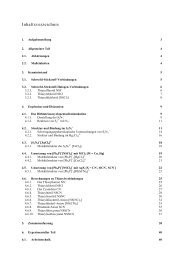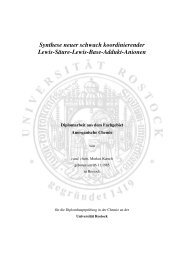Darstellung und Charakterisierung neuer niedrigkoordinierter ...
Darstellung und Charakterisierung neuer niedrigkoordinierter ...
Darstellung und Charakterisierung neuer niedrigkoordinierter ...
Create successful ePaper yourself
Turn your PDF publications into a flip-book with our unique Google optimized e-Paper software.
Phosphorus Attached to a N-N Unit<br />
PN double bond) and 3_3a (with a formal PN bond order ><br />
2) are fairly similar with 1.543 and 1.544 Å but elongated<br />
by 0.04 Å compared to that of 3_3b.In3_2a, the fairly short<br />
P-N bond can be explained by the intramolecular donoracceptor<br />
interaction of the p-LP at the adjacent N atom with<br />
the σ*(P-Cl) orbital similar to that in 3a or 3b, which is<br />
not possible in 3_3a (Figures 9, 11).<br />
Conclusions<br />
The reactions of diphenyl(chloro)phosphane and phenyl-<br />
(dichloro)phosphane with bis[lithium-tris(trimethylsilyl)-hydrazide]<br />
represent a fast and clean reaction resulting in the<br />
formation of hydrazinophosphanes 1 and 2 in high yields.<br />
Both species possess fairly small P-N bond lengths due to<br />
intramolecular donor-acceptor interactions and represent<br />
thermally stable (with respect to TMS-Cl elimination)<br />
compo<strong>und</strong>s. Hence, 1 and 2 represent ideal precursors for<br />
further synthesis of compo<strong>und</strong>s containing a NNP unit.<br />
Reaction with sulfur or selenium results in the formation of<br />
the oxidation products 4-7. Thermodynamic stabilization<br />
of the chlorine-containing systems appears in the important<br />
interaction between the nitrogen lone pair and the antibonding<br />
P-Cl σ* orbital. 37<br />
All three steps of the reaction of bis[lithium-tris(trimethylsilyl)-hydrazide]<br />
with phosphorus trichloride represent<br />
exothermic reactions. Large activation barriers are responsible<br />
for the thermal stability of 3a ((TMS)2N(TMS)PCl2),<br />
linear 3_2a ((TMS)2NNP-Cl), and cyclic 3_2r with respect<br />
to intramolecular TMS-Cl elimination. Investigation of the<br />
potential energy surface of (TMS)NNP revealed that 3_3c<br />
(TMS-PNN) represents the global minimum. The analysis<br />
of the chemical bonds using the NBO partitioning scheme<br />
shows a strong polarization of the N-P and N-Si bonds.<br />
Acknowledgment. A.S. thanks Professor Dr. T. M.<br />
Klapötke (LMU München) for his generous support and<br />
advice. We also thank the Leibniz Rechenzentrum for a<br />
generous allocation of CPU time. We are indebted to Dr. K.<br />
Karaghiosoff and Professor Dr. A. Schmidpeter for helpful<br />
advice and Dr. M. Suter for measuring an X-ray data set.<br />
Supporting Information Available: Experimental details for<br />
the synthesis of the oxidized compo<strong>und</strong>s ((TMS)2N-(TMS)N-<br />
P(S)Ph2 (4), (TMS)2N-(TMS)N-P(Se)Ph2 (5), (TMS)2N-(TMS)N-<br />
P(S)Ph(Cl) (6), (TMS)2N-(TMS)N-P(Se)Ph(Cl) (7)). X-ray crystallographic<br />
files in CIF format for the structure determinations of<br />
1, 2, 4, and 8 and the calculated structural data, energies, IRCs,<br />
and frequency data of all of the investigated species (archive<br />
entries). This material is available free of charge via the Internet at<br />
http://pubs.acs.org or from the author.<br />
IC048286M<br />
Inorganic Chemistry, Vol. 44, No. 6, 2005 1751


